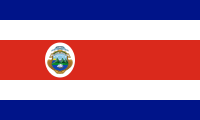 Costa Rica (pronounced /ˌkoʊstə ˈrikə/), officially the Republic of Costa Rica (Spanish: Costa Rica orRepública de Costa Rica, pronounced [reˈpuβlika ðe ˈkosta ˈrika]) is a country in Central America, bordered by Nicaragua to the north, Panama to the east and south, the Pacific Ocean to the west and south and the Caribbean Sea to the east.
Costa Rica (pronounced /ˌkoʊstə ˈrikə/), officially the Republic of Costa Rica (Spanish: Costa Rica orRepública de Costa Rica, pronounced [reˈpuβlika ðe ˈkosta ˈrika]) is a country in Central America, bordered by Nicaragua to the north, Panama to the east and south, the Pacific Ocean to the west and south and the Caribbean Sea to the east.
Costa Rica, which means “Rich Coast”, constitutionally abolished its army permanently in 1949. It is the only Latin American country included in the list of the world’s 22 older democracies. Costa Rica has consistently been among the top Latin American countries in terms of the Human Development Index, and ranked 54th in the world in 2007. The country is ranked 3rd in the world, and 1st among the Americas, in terms of the 2010 Environmental Performance Index.
In 2007 the Costa Rican government announced plans for Costa Rica to become the first carbon neutral country by 2021. According to the New Economics Foundation, Costa Rica ranks first in the Happy Planet Index and is the “greenest” country in the world.
Christopher Columbus landed in what is now Costa Rica in 1502, in an area inhabited by a number of small independent Indian tribes. These peoples were not easily dominated by European adventurers who followed, and it took some 60 years for the Spaniards to establish a permanent settlement there. Ignored by the Spanish crown because of its lack of mineral wealth, the colony grew slowly. Coffee exports and the construction of a rail line improved its economy in the 19th century. It joined the short-lived Mexican Empire in 1821, was a member of the United Provinces of Central America (1823 – 38), and adopted a constitution in 1871.
In 1890 Costa Ricans held what is considered the first free and honest election in Central America, beginning a tradition of democracy for which Costa Rica is renowned. In 1987 President Oscar Arias Sánchez was awarded the Nobel Prize for Peace for his Central American peace plan. In the early 21st century many Costa Ricans looked to increasingly free trade with the United States as a solution to the country’s economic woes.
Costa Rica was the point where the Mesoamerican and South American native cultures met. The northwest of the country, the Nicoya peninsula, was the southernmost point of Nahuatl cultural influence when the Spanish conquerors (conquistadores) came in the sixteenth century. The central and southern portions of the country had Chibcha influences. The Atlantic coast, meanwhile, was populated with African workers during the seventeenth and eighteenth centuries.
Costa Rica is an agricultural country, although tourism and industry are being developed at a moderate pace. Industries include food processing and the manufacture of electronic components, textiles and clothing, construction materials, fertilizer, and plastics. Bananas, pineapples, coffee, melons, sugar, and beef are exported, as well as manufactured goods such as textiles, electronics, and medical equipment. Raw materials, consumer goods, capital equipment, and petroleum are imported. The United States is the largest trading partner.
Notes from Wikipedia and Answers.com









